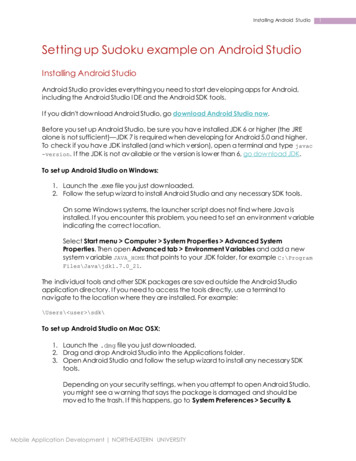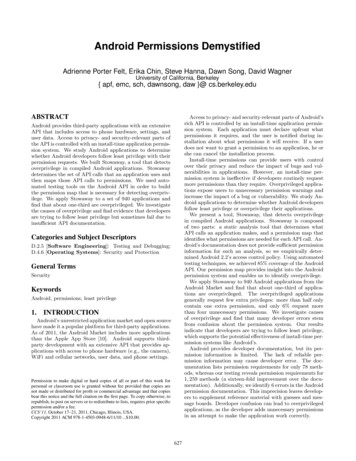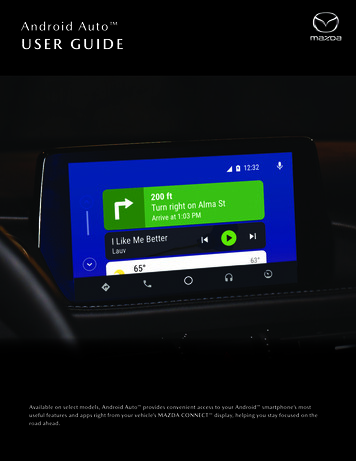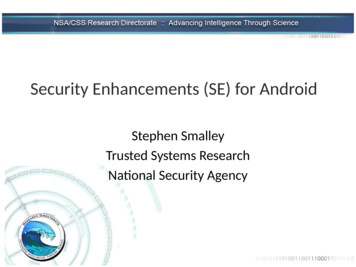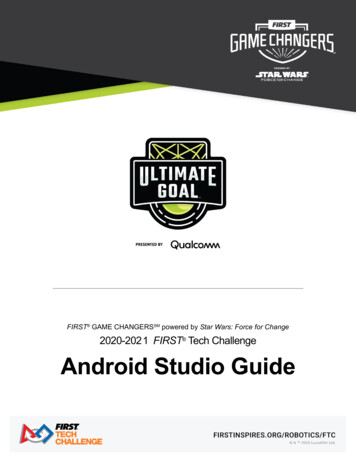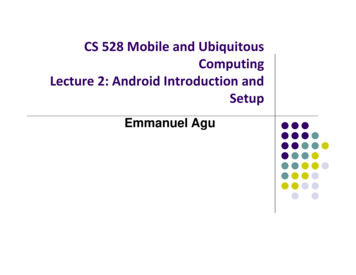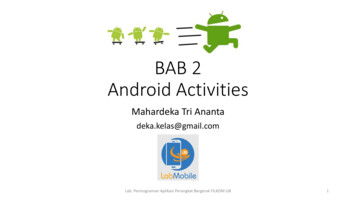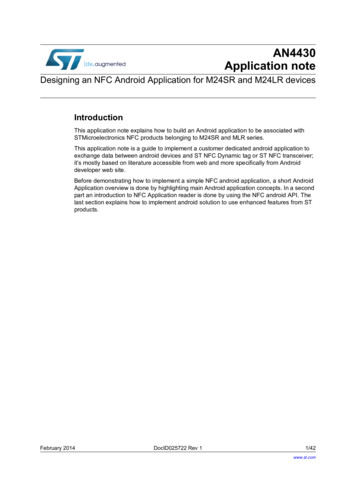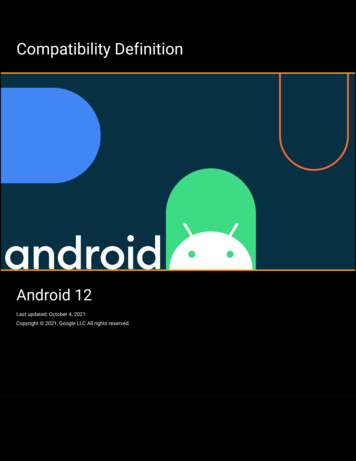
Transcription
Compatibility DefinitionAndroid 12Last updated: October 4, 2021Copyright 2021, Google LLC All rights reserved.
Table of Contents1. Introduction1.1 Document Structure1.1.1. Requirements by Device Type1.1.2. Requirement ID1.1.3. Requirement ID in Section 22. Device Types2.5.2. Multimedia2.5.3. Software2.5.4. Performance and Power2.5.5. Security Model2.5.6. Developer Tools and OptionsCompatibility2.6. Tablet Requirements2.1 Device Configurations2.6.1. Hardware2.2. Handheld Requirements2.6.2. Security Model2.2.1. Hardware2.2.2. Multimedia2.2.3. Software2.2.4. Performance and Power2.2.5. Security Model2.2.6. Developer Tools and OptionsCompatibility2.2.7. Handheld Media Performance Class2.2.7.1. Media2.2.7.2. Camera2.2.7.3. Hardware2.2.7.4. Performance2.3. Television Requirements2.3.1. Hardware2.3.2. Multimedia2.3.3. Software2.3.4. Performance and Power2.3.5. Security Model2.3.6. Developer Tools and OptionsCompatibility2.4. Watch Requirements2.4.1. Hardware2.4.2. Multimedia2.4.3. Software2.4.4. Performance and Power2.4.5. Security Model2.5. Automotive Requirements2.5.1. Hardware2.6.2. Software3. Software3.1. Managed API Compatibility3.1.1. Android Extensions3.1.2. Android Library3.2. Soft API Compatibility3.2.1. Permissions3.2.2. Build Parameters3.2.3. Intent Compatibility3.2.3.1. Common Application Intents3.2.3.2. Intent Resolution3.2.3.3. Intent Namespaces3.2.3.4. Broadcast Intents3.2.3.5. Conditional Application Intents3.2.4. Activities on secondary/multipledisplays3.3. Native API Compatibility3.3.1. Application Binary Interfaces3.3.2. 32-bit ARM Native Code Compatibility3.4. Web Compatibility3.4.1. WebView Compatibility3.4.2. Browser Compatibility3.5. API Behavioral Compatibility3.5.1. Application Restriction3.5.2. Application Hibernation3.6. API Namespaces3.7. Runtime CompatibilityPage 2 of 142
3.8. User Interface Compatibility3.8.1. Launcher (Home Screen)3.8.2. Widgets3.8.3. Notifications3.8.3.1. Presentation of Notifications3.8.3.2. Notification Listener Service3.8.3.3. DND (Do not Disturb)3.18. Contacts4. Application Packaging Compatibility5. Multimedia Compatibility5.1. Media Codecs5.1.1. Audio Encoding5.1.2. Audio Decoding3.8.4. Assist API's5.1.3. Audio Codecs Details3.8.5. Alerts and Toasts5.1.4. Image Encoding3.8.6. Themes5.1.5. Image Decoding3.8.7. Live Wallpapers5.1.6. Image Codecs Details3.8.8. Activity Switching5.1.7. Video Codecs3.8.9. Input Management5.1.8. Video Codecs List3.8.10. Lock Screen Media Control5.1.9. Media Codec Security3.8.11. Screen savers (previously Dreams)3.8.12. Location5.1.10. Media Codec Characterization5.2. Video Encoding3.8.13. Unicode and Font5.2.1. H.2633.8.14. Multi-windows5.2.2. H.2643.8.15. Display Cutout5.2.3. VP83.8.16. Device Controls5.2.4. VP93.9. Device Administration3.9.1 Device Provisioning3.9.1.1 Device owner provisioning3.9.1.2 Managed profile provisioning3.9.2 Managed Profile Support3.9.3 Managed User Support3.10. Accessibility5.2.5. H.2655.3. Video Decoding5.3.1. MPEG-25.3.2. H.2635.3.3. MPEG-45.3.4. H.2645.3.5. H.265 (HEVC)3.11. Text-to-Speech5.3.6. VP83.12. TV Input Framework5.3.7. VP93.13. Quick Settings5.3.8. Dolby Vision3.14. Media UI3.15. Instant Apps3.16. Companion Device Pairing3.17. Heavyweight Apps5.3.9. AV15.4. Audio Recording5.4.1. Raw Audio Capture and MicrophoneInformation5.4.2. Capture for Voice Recognition5.4.3. Capture for Rerouting of PlaybackPage 3 of 142
5.4.4. Acoustic Echo Canceler7.2. Input Devices5.4.5. Concurrent Capture7.2.1. Keyboard5.4.6. Microphone Gain Levels7.2.2. Non-touch Navigation5.5. Audio Playback7.2.3. Navigation Keys5.5.1. Raw Audio Playback7.2.4. Touchscreen Input5.5.2. Audio Effects7.2.5. Fake Touch Input5.5.3. Audio Output Volume7.2.6. Game Controller Support7.2.6.1. Button Mappings5.5.4. Audio Offload5.6. Audio Latency5.7. Network Protocols7.2.7. Remote Control7.3. Sensors5.8. Secure Media7.3.1. Accelerometer5.9. Musical Instrument Digital Interface(MIDI)7.3.2. Magnetometer5.10. Professional Audio7.3.4. Gyroscope5.11. Capture for Unprocessed7.3.5. Barometer6. Developer Tools and OptionsCompatibility7.3.7. Photometer6.1. Developer Tools6.2. Developer Options7. Hardware Compatibility7.1. Display and Graphics7.1.1. Screen Configuration7.1.1.1. Screen Size and Shape7.1.1.2. Screen Aspect Ratio7.1.1.3. Screen Density7.1.2. Display Metrics7.1.3. Screen Orientation7.1.4. 2D and 3D Graphics Acceleration7.1.4.1 OpenGL ES7.1.4.2 Vulkan7.1.4.3 RenderScript7.1.4.4 2D Graphics Acceleration7.1.4.5 Wide-gamut Displays7.1.5. Legacy Application Compatibility Mode7.3.3. GPS7.3.6. Thermometer7.3.8. Proximity Sensor7.3.9. High Fidelity Sensors7.3.10. Biometric Sensors7.3.12. Pose Sensor7.3.13. Hinge Angle Sensor7.4. Data Connectivity7.4.1. Telephony7.4.1.1. Number Blocking Compatibility7.4.1.2. Telecom API7.4.2. IEEE 802.11 (Wi-Fi)7.4.2.1. Wi-Fi Direct7.4.2.2. Wi-Fi Tunneled Direct Link Setup7.4.2.3. Wi-Fi Aware7.4.2.4. Wi-Fi Passpoint7.4.2.5. Wi-Fi Location (Wi-Fi Round TripTime - RTT)7.4.2.6. Wi-Fi Keepalive Offload7.4.2.7. Wi-Fi Easy Connect (DeviceProvisioning Protocol)7.1.6. Screen Technology7.1.7. Secondary DisplaysPage 4 of 142
7.4.2.7. Enterprise Wi-Fi Server CertificateValidation8. Performance and Power7.4.3. Bluetooth8.1. User Experience Consistency7.4.4. Near-Field Communications8.2. File I/O Access Performance7.4.5. Networking protocols and APIs7.4.5.1. Minimum Network Capability7.4.5.2. IPv67.4.5.3. Captive Portals8.3. Power-Saving Modes7.4.6. Sync Settings8.4. Power Consumption Accounting8.5. Consistent Performance9. Security Model Compatibility7.4.7. Data Saver9.1. Permissions7.4.8. Secure Elements9.2. UID and Process Isolation7.5. Cameras9.3. Filesystem Permissions7.5.1. Rear-Facing Camera9.4. Alternate Execution Environments7.5.2. Front-Facing Camera9.5. Multi-User Support7.5.3. External Camera9.6. Premium SMS Warning7.5.4. Camera API Behavior7.5.5. Camera Orientation7.6. Memory and Storage7.6.1. Minimum Memory and Storage7.6.2. Application Shared Storage7.6.3. Adoptable Storage7.7. USB7.7.1. USB peripheral mode7.7.2. USB host mode7.8. Audio9.7. Security Features9.8. Privacy9.8.1. Usage History9.8.2. Recording9.8.3. Connectivity9.8.4. Network Traffic9.8.5. Device Identifiers9.8.6. Content Capture and App Search9.8.7. Clipboard Access9.8.8. Location7.8.1. Microphone9.8.9. Installed apps7.8.2. Audio Output7.8.2.1. Analog Audio Ports7.8.2.2. Digital Audio Ports9.8.10. Connectivity Bug Report7.8.3. Near-Ultrasound7.8.4. Signal Integrity7.9. Virtual Reality7.9.1. Virtual Reality Mode7.9.2. Virtual Reality Mode - HighPerformance7.10. Haptics9.8.11. Data blobs sharing9.8.12. Music Recognition9.8.13. SensorPrivacyManager9.9. Data Storage Encryption9.9.1. Direct Boot9.9.2. Encryption requirements9.9.3. Encryption Methods9.9.4. Resume on Reboot9.10. Device IntegrityPage 5 of 142
9.11. Keys and Credentials9.11.1. Secure Lock Screen andAuthentication9.11.2. StrongBox9.11.3. Identity Credential9.12. Data Deletion9.13. Safe Boot Mode9.14. Automotive Vehicle System Isolation9.15. Subscription Plans9.16. Application Data Migration10. Software Compatibility Testing10.1. Compatibility Test Suite10.2. CTS Verifier11. Updatable Software12. Document Changelog13. Contact UsPage 6 of 142
1. IntroductionThis document enumerates the requirements that must be met in order for devices to be compatiblewith Android 12.The use of “MUST”, “MUST NOT”, “REQUIRED”, “SHALL”, “SHALL NOT”, “SHOULD”, “SHOULD NOT”,“RECOMMENDED”, “MAY”, and “OPTIONAL” is per the IETF standard defined in RFC2119 .As used in this document, a “device implementer” or “implementer” is a person or organizationdeveloping a hardware/software solution running Android 12. A “device implementation” or“implementation" is the hardware/software solution so developed.To be considered compatible with Android 12, device implementations MUST meet the requirementspresented in this Compatibility Definition, including any documents incorporated via reference.Where this definition or the software tests described in section 10 is silent, ambiguous, orincomplete, it is the responsibility of the device implementer to ensure compatibility with existingimplementations.For this reason, the Android Open Source Project is both the reference and preferred implementationof Android. Device implementers are STRONGLY RECOMMENDED to base their implementations tothe greatest extent possible on the “upstream” source code available from the Android Open SourceProject. While some components can hypothetically be replaced with alternate implementations, it isSTRONGLY RECOMMENDED to not follow this practice, as passing the software tests will becomesubstantially more difficult. It is the implementer’s responsibility to ensure full behavioralcompatibility with the standard Android implementation, including and beyond the Compatibility TestSuite. Finally, note that certain component substitutions and modifications are explicitly forbidden bythis document.Many of the resources linked to in this document are derived directly or indirectly from the AndroidSDK and will be functionally identical to the information in that SDK’s documentation. In any caseswhere this Compatibility Definition or the Compatibility Test Suite disagrees with the SDKdocumentation, the SDK documentation is considered authoritative. Any technical details provided inthe linked resources throughout this document are considered by inclusion to be part of thisCompatibility Definition.1.1 Document Structure1.1.1. Requirements by Device TypeSection 2 contains all of the requirements that apply to a specific device type. Each subsection ofSection 2 is dedicated to a specific device type.All the other requirements, that universally apply to any Android device implementations, are listed inthe sections after Section 2 . These requirements are referenced as "Core Requirements" in thisdocument.1.1.2. Requirement IDRequirement ID is assigned for MUST requirements.The ID is assigned for MUST requirements only.STRONGLY RECOMMENDED requirements are marked as [SR] but ID is not assigned.The ID consists of : Device Type ID - Condition ID - Requirement ID (e.g. C-0-1).Each ID is defined as below:Device Type ID (see more in 2. Device Types )C: Core (Requirements that are applied to all Android device implementations)H: Android Handheld deviceT: Android Television deviceA: Android Automotive implementationW: Android Watch implementationTab: Android Tablet implementationCondition IDWhen the requirement is unconditional, this ID is set as 0.When the requirement is conditional, 1 is assigned for the 1st condition andthe number increments by 1 within the same section and the same devicetype.Requirement IDThis ID starts from 1 and increments by 1 within the same section and thesame condition.Page 7 of 142
1.1.3. Requirement ID in Section 2The Requirement IDs in Section 2 have two parts. The first corresponds to a section ID as describedabove. The second part identifies the form factor and the form-factor specific requirement.section ID that is followed by the Requirement ID described above.The ID in Section 2 consists of : Section ID / Device Type ID - Condition ID - RequirementID (e.g. 7.4.3/A-0-1).2. Device TypesThe Android Open Source Project provides a software stack that can be used for a variety of devicetypes and form factors. To support security on devices, the software stack, including anyreplacement OS or an alternate kernel implementation, is expected to execute in a secureenvironment as described in section 9 and elsewhere within this CDD. There are a few device typesthat have a relatively better established application distribution ecosystem.This section describes those device types, and additional requirements and recommendationsapplicable for each device type.All Android device implementations that do not fit into any of the described device types MUST stillmeet all requirements in the other sections of this Compatibility Definition.2.1 Device ConfigurationsFor the major differences in hardware configuration by device type, see the device-specificrequirements that follow in this section.2.2. Handheld RequirementsAn Android Handheld device refers to an Android device implementation that is typically used byholding it in the hand, such as an mp3 player, phone, or tablet.Android device implementations are classified as a Handheld if they meet all the following criteria:Have a power source that provides mobility, such as a battery.Have a physical diagonal screen size in the range of 3.3 inches (or 2.5 inches for deviceswhich launched on an API level earlier than Android 11) to 8 inches.The additional requirements in the rest of this section are specific to Android Handheld deviceimplementations.Note: Requirements that do not apply to Android Tablet devices are marked with an *.2.2.1. HardwareHandheld device implementations:[ 7.1 .1.1/H-0-1] MUST have at least one Android-compatible display that meets allrequirements described on this document.[ 7.1 .1.3/H-SR] Are STRONGLY RECOMMENDED to provide users an affordance tochange the display size (screen density).[ 7.1 .1.1/H-0-2] MUST support GPU composition of graphic buffers at least as large asthe highest resolution of any built-in display.If Handheld device implementations support software screen rotation, they:[ 7.1 .1.1/H-1-1]* MUST make the logical screen that is made available for third partyapplications be at least 2 inches on the short edge(s) and 2.7 inches on the long edge(s).Devices which launched on an API level earlier than that of this document are exemptedfrom this requirement.If Handheld device implementations do not support software screen rotation, they:[ 7.1 .1.1/H-2-1]* MUST make the logical screen that is made available for third partyapplications be at least 2.7 inches on the short edge(s). Devices which launched on anAPI level earlier than that of this document are exempted from this requirement.If Handheld device implementations claim support for high dynamic range displays throughConfiguration.isScreenHdr() , they:Page 8 of 142
[ 7.1 .4.5/H-1-1] MUST advertise support for the EGL EXT gl colorspace bt2020 pq ,EGL EXT surface SMPTE2086 metadata , EGL EXT surface CTA861 3 metadata ,VK EXT swapchain colorspace , and VK EXT hdr metadata extensions.Handheld device implementations:[ 7.1 .4.6/H-0-1] MUST report whether the device supports the GPU profiling capability viaa system property graphics.gpu.profiler.support .If Handheld device implementations declare support via a system property graphics.gpu.profiler.support, they:[ 7.1 .4.6/H-1-1] MUST report as output a protobuf trace that complies with the schemafor GPU counters and GPU renderstages defined in the Perfetto documentation .[ 7.1 .4.6/H-1-2] MUST report conformant values for the device’s GPU counters followingthe gpu counter trace packet proto .[ 7.1 .4.6/H-1-3] MUST report conformant values for the device’s GPU RenderStagesfollowing the render stage trace packet proto .[ 7.1 .4.6/H-1-4] MUST report a GPU Frequency tracepoint as specified by the format:power/gpu frequency .Handheld device implementations:[ 7.1 .5/H-0-1] MUST include support for legacy application compatibility mode asimplemented by the upstream Android open source code. That is, device implementationsMUST NOT alter the triggers or thresholds at which compatibility mode is activated, andMUST NOT alter the behavior of the compatibility mode itself.[ 7.2 .1/H-0-1] MUST include support for third-party Input Method Editor (IME)applications.[ 7.2 .3/H-0-3] MUST provide the Home function on all the Android-compatible displaysthat provide the home screen.[ 7.2 .3/H-0-4] MUST provide the Back function on all the Android-compatible displays andthe Recents function on at least one of the Android-compatible displays.[ 7.2 .3/H-0-2] MUST send both the normal and long press event of the Back function (KEYCODE BACK ) to the foreground application. These events MUST NOT be consumedby the system and CAN be triggered by outside of the Android device (e.g. externalhardware keyboard connected to the Android device).[ 7.2 .4/H-0-1] MUST support touchscreen input.[ 7.2 .4/H-SR] Are STRONGLY RECOMMENDED to launch the user-selected assist app, inother words the app that implements VoiceInteractionService, or an activity handling theACTION ASSIST on long-press of KEYCODE MEDIA PLAY PAUSE orKEYCODE HEADSETHOOK if the foreground activity does not handle those long-pressevents.[ 7.3 .1/H-SR] Are STRONGLY RECOMMENDED to include a 3-axis accelerometer.If Handheld device implementations include a 3-axis accelerometer, they:[ 7.3 .1/H-1-1] MUST be able to report events up to a frequency of at least 100 Hz.If Handheld device implementations include a GPS/GNSS receiver and report the capability toapplications through the android.hardware.location.gps feature flag, they:[ 7.3 .3/H-2-1] MUST report GNSS measurements, as soon as they are found, even if alocation calculated from GPS/GNSS is not yet reported.[ 7.3 .3/H-2-2] MUST report GNSS pseudoranges and pseudorange rates, that, in open-skyconditions after determining the location, while stationary or moving with less than 0.2meter per second squared of acceleration, are sufficient to calculate position within 20meters, and speed within 0.2 meters per second, at least 95% of the time.If Handheld device implementations include a 3-axis gyroscope, they:[ 7.3 .4/H-3-1] MUST be able to report events up to a frequency of at least 100 Hz.[ 7.3 .4/H-3-2] MUST be capable of measuring orientation changes up to 1000 degreesper second.Handheld device implementations that can make a voice call and indicate any value other thanPHONE TYPE NONE in getPhoneType :[ 7.3 .8/H] SHOULD include a proximity sensor.Page 9 of 142
Handheld device implementations:[ 7.3 .11/H-SR] Are RECOMMENDED to support pose sensor with 6 degrees of freedom.[ 7.4 .3/H] SHOULD include support for Bluetooth and Bluetooth LE.If Handheld device implementations include a metered connection, they:[ 7.4 .7/H-1-1] MUST provide the data saver mode.If Handheld device implementations include a logical camera device that lists capabilities usingCameraMetadata.REQUEST AVAILABLE CAPABILITIES LOGICAL MULTI CAMERA , they:[ 7.5 .4/H-1-1] MUST have normal field of view (FOV) by default and it MUST be between50 and 90 degrees.Handheld device implementations:[ 7.6 .1/H-0-1] MUST have at least 4 GB of non-volatile storage available for applicationprivate data (a.k.a. "/data" partition).[ 7.6 .1/H-0-2] MUST return “true” for ActivityManager.isLowRamDevice() when there is lessthan 1GB of memory available to the kernel and userspace.If Handheld device implementations declare support of only a 32-bit ABI:[ 7.6 .1/H-1-1] The memory available to the kernel and userspace MUST be at least416MB if the default display uses framebuffer resolutions up to qHD (e.g. FWVGA).[ 7.6 .1/H-2-1] The memory available to the kernel and userspace MUST be at least592MB if the default display uses framebuffer resolutions up to HD (e.g. HD, WSVGA).[ 7.6 .1/H-3-1] The memory available to the kernel and userspace MUST be at least896MB if the default display uses framebuffer resolutions up to FHD (e.g. WSXGA ).[ 7.6 .1/H-4-1] The memory available to the kernel and userspace MUST be at least1344MB if the default display uses framebuffer resolutions up to QHD (e.g. QWXGA).If Handheld device implementations declare support of 32-bit and 64-bit ABIs:[ 7.6 .1/H-5-1] The memory available to the kernel and userspace MUST be at least816MB if the default display uses framebuffer resolutions up to qHD (e.g. FWVGA).[ 7.6 .1/H-6-1] The memory available to the kernel and userspace MUST be at least944MB if the default display uses framebuffer resolutions up to HD (e.g. HD, WSVGA).[ 7.6 .1/H-7-1] The memory available to the kernel and userspace MUST be at least1280MB if the default display uses framebuffer resolutions up to FHD (e.g. WSXGA ).[ 7.6 .1/H-8-1] The memory available to the kernel and userspace MUST be at least1824MB if the default display uses framebuffer resolutions up to QHD (e.g. QWXGA).Note that the "memory available to the kernel and userspace" above refers to the memory spaceprovided in addition to any memory already dedicated to hardware components such as radio, video,and so on that are not under the kernel’s control on device implementations.If Handheld device implementations include less than or equal to 1GB of memory available to thekernel and userspace, they:[ 7.6 .1/H-9-1] MUST declare the feature flag android.hardware.ram.low .[ 7.6 .1/H-9-2] MUST have at least 1.1 GB of non-volatile storage for application privatedata (a.k.a. "/data" partition).If Handheld device implementations include more than 1GB of memory available to the kernel anduserspace, they:[ 7.6 .1/H-10-1] MUST have at least 4GB of non-volatile storage available for applicationprivate data (a.k.a. "/data" partition).SHOULD declare the feature flag android.hardware.ram.normal .If Handheld device implementations include greater than or equal to 2GB and less than 4GB ofmemory available to the kernel and userspace, they: * [7.6.1/H-SR] Are STRONGLY RECOMMENDEDto support only 32-bit userspace (both apps and system code)If Handheld device implementations include less than 2GB of memory available to the kernel anduserspace, they: * [7.6.1/H-1-1] MUST support only 32-bit ABIs.Page 10 of 142
Handheld device implementations:[ 7.6 .2/H-0-1] MUST NOT provide an application shared storage smaller than 1 GiB.[ 7.7 .1/H] SHOULD include a USB port supporting peripheral mode.If handheld device implementations include a USB port supporting peripheral mode, they:[ 7.7 .1/H-1-1] MUST implement the Android Open Accessory (AOA) API.If Handheld device implementations include a USB port supporting host mode, they:[ 7.7 .2/H-1-1] MUST implement the USB audio class as documented in the Android SDKdocumentation.Handheld device implementations:[ 7.8 .1/H-0-1] MUST include a microphone.[ 7.8 .2/H-0-1] MUST have an audio output and declare android.hardware.audio.output .If Handheld device implementations are capable of meeting all the performance requirements forsupporting VR mode and include support for it, they:[ 7.9 .1/H-1-1] MUST declare the android.hardware.vr.high performance feature flag.[ 7.9 .1/H-1-2] MUST include an application implementingandroid.service.vr.VrListenerService that can be enabled by VR applications viaandroid.app.Activity#setVrModeEnabled .If Handheld device implementations include one or more USB-C port(s) in host mode and implement(USB audio class), in addition to requirements in section 7.7.2 , they:[ 7.8 .2.2/H-1-1] MUST provide the following software mapping of HID codes:FunctionMappingsContextBehaviorInput : Short pressOutput : Play or pauseAInput : Long pressOutput : Launch voice commandMediaplayback Sends :android.speech.action.VOICE SEARCH HANDS FREE ifthe device is locked or its screen is off. Sendsandroid.speech.RecognizerIntent.ACTION WEB SEARCHotherwiseHID usage page : 0x0CHID usage : 0x0CDKernel key : KEY PLAYPAUSEInput : Short pressAndroid key :KEYCODE MEDIA PLAY PAUSE Incoming Output : Accept callcallInput : Long pressOutput : Reject callOngoingcallInput : Short pressOutput : End callInput : Long pressOutput : Mute or unmute microphoneBHID usage page : 0x0CHID usage : 0x0E9Kernel key : KEY VOLUMEUPAndroid key : VOLUME UPMediaplayback, Input : Short or long pressOngoing Output : Increases the system or headset volumecallCHID usage page : 0x0CHID usage : 0x0EAKernel key :KEY VOLUMEDOWNAndroid key : VOLUME DOWNMediaplayback, Input : Short or long pressOngoing Output : Decreases the system or headset volumecallDHID usage page : 0x0CHID usage : 0x0CFKernel key :KEY VOICECOMMANDAndroid key :KEYCODE VOICE ASSISTAll. Canbetriggered Input : Short or long pressOutput : Launch voice commandin anyinstance.Page 11 of 142
[ 7.8 .2.2/H-1-2] MUST trigger ACTION HEADSET PLUG upon a plug insert, but only afterthe USB audio interfaces and endpoints have been properly enumerated in order toidentify the type of terminal connected.When the USB audio terminal types 0x0302 is detected, they:[ 7.8 .2.2/H-2-1] MUST broadcast Intent ACTION HEADSET PLUG with "microphone"extra set to 0.When the USB audio terminal types 0x0402 is detected, they:[ 7.8 .2.2/H-3-1] MUST broadcast Intent ACTION HEADSET PLUG with "microphone"extra set to 1.When API AudioManager.getDevices() is called while the USB peripheral is connected they:[ 7.8 .2.2/H-4-1] MUST list a device of type AudioDeviceInfo.TYPE USB HEADSET androle isSink() if the USB audio terminal type field is 0x0302.[ 7.8 .2.2/H-4-2] MUST list a device of type AudioDeviceInfo.TYPE USB HEADSET androle isSink() if the USB audio terminal type field is 0x0402.[ 7.8 .2.2/H-4-3] MUST list a device of type AudioDeviceInfo.TYPE USB HEADSET androle isSource() if the USB audio terminal type field is 0x0402.[ 7.8 .2.2/H-4-4] MUST list a device of type AudioDeviceInfo.TYPE USB DEVICE and roleisSink() if the USB audio terminal type field is 0x603.[ 7.8 .2.2/H-4-5] MUST list a device of type AudioDeviceInfo.TYPE USB DEVICE and roleisSource() if the USB audio terminal type field is 0x604.[ 7.8 .2.2/H-4-6] MUST list a device of type AudioDeviceInfo.TYPE USB DEVICE and roleisSink() if the USB audio terminal type field is 0x400.[ 7.8 .2.2/H-4-7] MUST list a device of type AudioDeviceInfo.TYPE USB DEVICE and roleisSource() if the USB audio terminal type field is 0x400.[ 7.8 .2.2/H-SR] Are STRONGLY RECOMMENDED upon connection of a USB-C audioperipheral, to perform enumeration of USB descriptors, identify terminal types andbroadcast Intent ACTION HEADSET PLUG in less than 1000 milliseconds.If Handheld device implementations declare android.hardware.audio.output andandroid.hardware.microphone , they:[5.6(#5 6 audio-latency)/H-1-1] MUST have a Mean Continuous Round-Trip latency of800 milliseconds or less over 5 measurements, with a Mean Absolute Deviation less than100 ms, over at least one supported path.If Handheld device implementations include at least one haptic actuator, they:[ 7.10 /H]* SHOULD NOT use an eccentric rotating mass (ERM) haptic actuator (vibrator).[ 7.10 /H]* SHOULD position the placement of the actuator near the location where thedevice is typically held or touched by hands.[ 7.10 /H]* SHOULD implement all public constants for clear haptics inandroid.view.HapticFeedbackConstants namely (CLOCK TICK, CONTEXT CLICK,KEYBOARD PRESS, KEYBOARD RELEASE, KEYBOARD TAP, LONG PRESS,TEXT HANDLE MOVE, VIRTUAL KEY, VIRTUAL KEY RELEASE, CONFIRM, REJECT,GESTURE START and GESTURE END).[ 7.10 /H]* SHOULD implement all public constants for clear haptics inandroid.os.VibrationEffect namely (EFFECT TICK, EFFECT CLICK, EFFECT HEAVY CLICKand EFFECT DOUBLE CLICK) and all public constants for rich haptics inandroid.os.VibrationEffect.Composition namely (PRIMITIVE CLICK and PRIMITIVE TICK).[ 7.10 /H]* SHOULD use these linked haptic constants mappings .[ 7.10 /H]* SHOULD follow quality assessment for ong,%20int))and (long[],%20int))API's.[ 7.10 /H]* SHOULD verify the capabilities for amplitude scalability by s/Vibrator#hasAmplitudeControl()).A linear resonant actuator (LRA) is a single-mass spring system which has a dominant resonantfrequency where the mass translates in the direction of desired motion.Page 12 of 142
If Handheld device implementations include at least one linear resonant actuator, they:[ 7.10 /H]* SHOULD move the haptic actuator in the X-axis of portrait orientation.If Handheld device implementations have a haptic actuator which is X-axis linear resonant actuator(LRA), they:[ 7.10 /H]* SHOULD have the resonant frequency of the X-axis LRA be under 200 Hz.If handheld device implementations follow haptic constants mapping, they:[7.10/H]* SHOULD verify the implementation status by d/os/Vibrator#areAllEffectsSupported(int.))and android.os.Vibrator.arePrimitvesSupported() API's.[ 7.10 /H]* SHOULD perform a quality assessment for haptic constants.[7.10/H]* SHOULD provide fallback support to mitigate the risk of failure as describedhere .2.2.2. MultimediaHandheld device implementations MUST support the following audio encoding and decoding formatsand make them available to third-party applications:[ 5.1 /H-0-1] AMR-NB[ 5.1 /H-0-2] AMR-WB[ 5.1 /H-0-3] MPEG-4 AAC Profile (AAC LC)[ 5.1 /H-0-4] MPEG-4 HE AAC Profile (AAC )[ 5.1 /H-0-5] AAC ELD (enhanced low delay AAC)Handheld device implementations MUST support the following video encoding formats and makethem available to third-party applications:[ 5.2 /H-0-1] H.264 AVC[ 5.2 /H-0-2] VP8Handheld device implementations MUST support the following video decoding formats and makethem available to third-party applications:[ 5.3 /H-0-1] H.264 AVC[ 5.3 /H-0-2] H.265 HEVC[ 5.3 /H-0-3] MPEG-4 SP[ 5.3 /H-0-4] VP8[ 5.3 /H-0-5] VP92.2.3. SoftwareHandheld device implementations:[ 3.2.3.1 /H-0-1] MUST have an application that handles the ACTION GET CONTENT ,ACTION OPEN DOCUMENT , ACTION OPEN DOCUMENT TREE , andACTION CREATE DOCUMENT intents as described in the SDK documents, and providethe user affordance to access the document provider data by using DocumentsProviderAPI.[ 3.2.3.1 /H-0-2]* MUST preload one or more applications or service components with anintent handler, for all the public intent filter patterns defined by the following applicationintents listed here .[ 3.2.3.1 /H-SR] Are STRONGLY RECOMMENDED to preload an email application whichcan handle ACTION SENDTO or ACTION SEND or ACTION SEND MULTIPLE intents tosend an email.[ 3.4 .1/H-0-1] MUST provide a complete implementation of
Oct 4, 2021



